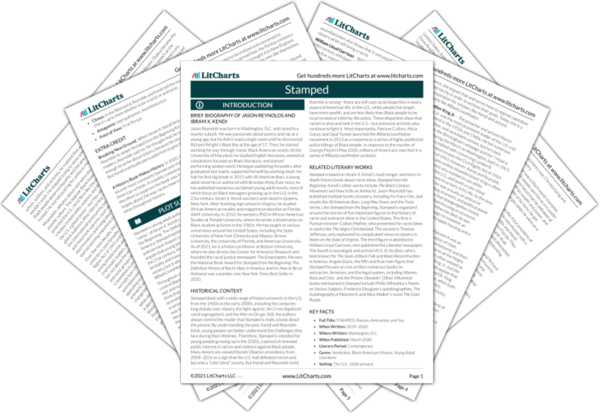Antiracists Quotes in Stamped
The segregationists and the assimilationists are challenged by antiracists. The antiracists say there is nothing wrong or right about Black people and everything wrong with racism. The antiracists say racism is the problem in need of changing, not Black people. The antiracists try to transform racism. The assimilationists try to transform Black people. The segregationists try to get away from Black people. These are the three distinct racial positions you will hear throughout Stamped: Racism, Antiracism, and You—the segregationists, the assimilationists, and the antiracists, and how they each have rationalized racial inequity.
The first step to building an antiracist America is acknowledging America's racist past. By acknowledging American racist past, we can acknowledge America's racist present. In acknowledging America's racist present, we can work toward building an antiracist America.
Segregationists are haters. Like, real haters. People who hate you for not being like them. Assimilationists are people who like you, but only with quotation marks. Like…“like” you. Meaning, they “like” you because you’re like them. And then there are antiracists. They love you because you’re like you.
But not everyone was kissing Du Bois’s assimilationist feet. There was a resistant group of artists that emerged in 1926 who called themselves the Niggerati. They believed they should be able to make whatever they wanted to express themselves as whole humans without worrying about White acceptance. […] They wanted to function the same way as the blues women, like Ma Rainey and Bessie Smith, who sang about pain and sex and whatever else they wanted to. Even if the images of Blackness weren’t always positive. W. E. B. Du Bois and his supporters of uplift suasion and media suasion had a hard time accepting any narrative of Black people being less than perfect. Less than dignified. But the Niggerati were arguing that, if Black people couldn’t be shown as imperfect, they couldn’t be shown as human.
It was 1933. Du Bois’s life as an assimilationist had finally started to vaporize. He just wanted Black people to be self-sufficient. To be Black. And for that to be enough. Here he argued that the American educational system was failing the country because it wouldn’t tell the truth about race in America, because it was too concerned with protecting and defending the White race. Ultimately, he was arguing what he’d been arguing in various different ways, and what Frederick Douglass, Sojourner Truth, Booker T. Washington, Ida B. Wells-Barnett, Marcus Garvey, and many others before him had argued ad nauseam: that Black people were human.
King closed the day with what’s probably the most iconic speech of all time—“I Have a Dream.” But there was bad news. W. E. B. Du Bois had died in his sleep the previous day.
Indeed, a younger Du Bois had called for such a gathering, hoping it would persuade millions of White people to love the lowly souls of Black folk. And, yes, the older Du Bois had chosen another path—the antiracist path less traveled—toward forcing millions to accept the equal souls of Black folk. It was the path of civil disobedience that the young marchers […] had desired for the March on Washington, a path a young woman from Birmingham’s Dynamite Hill was already traveling and would never leave.
[Malcolm X’s] ideological transformation, from assimilationist to anti-White separatist to antiracist, inspired millions. He argued that though White people weren’t born racist, America was built to make them that way. And that if they wanted to fight against it, they had to address it with the other racist White people around them. He critiqued Black assimilationists. Called them puppets, especially the “leaders” who had exploited their own people to climb the White ladder. Malcolm X stamped that he was for truth—not hate—truth and truth alone, no matter where it was coming from. His autobiography would become antiracist scripture. It would become one of the most important books in American history.
Angela Davis. She was the conference’s closing speaker. She was certainly the nation’s most famous Black American woman academic. But, more important, over the course of her career, she had consistently defended Black women, including those Black women who even some Black women did not want to defend. She had been arguably America’s most antiracist voice over the past two decades, unwavering in her search for antiracist explanations when others took the easier and racist way of Black blame.
Alicia Garza, Patrisse Cullors, and Opal Tometi founded #BlackLivesMatter as a direct response to racist backlash in the form of police brutality. From the minds and hearts of these three Black women—two of whom are queer—this declaration of love intuitively signified that in order to truly be antiracists, we must also oppose all the sexism, homophobia, colorism, ethnocentrism, nativism, cultural prejudice, and class bias teeming and teaming with racism to harm so many Black lives. […] In reaction to those who acted as if Black male lives mattered the most, antiracist feminists boldly demanded of America to #SayHerName, to shine light on the women who have also been affected by the hands and feet of racism. Perhaps they, the antiracist daughters of Davis, should be held up as symbols of hope, for taking potential and turning it into power. More important, perhaps we should all do the same.
[It all] leads back to the question of whether you, reader, want to be a segregationist (a hater), an assimilationist (a coward), or an antiracist (someone who truly loves).
Choice is yours.
Don’t freak out.
Just breathe in. Inhale. Hold it. Now exhale slowly:
N O W.












